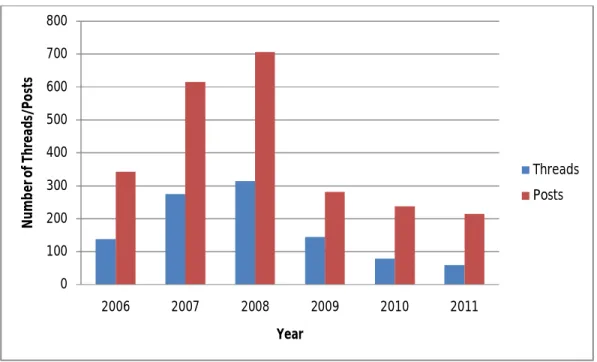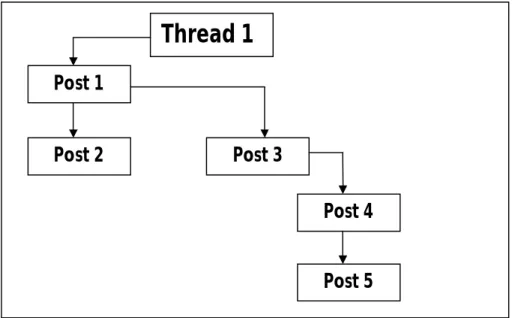Submitted in partial fulfillment of the requirements for the Master of Social Sciences (Research Psychology) at the Faculty of Psychology, University of KwaZulu-Natal, Pietermaritzburg. An e-mail discussion list hosted on the Internet by a South African tertiary education institution offers researchers the opportunity to examine how list members manage text conversation with each other. Depending on the context of the study, race is the "elephant" in the room, or in this case the online space, that can be pointed out at any time in the discussion list conversation.
Introduction
The Transformation of Higher Education in South Africa
Situating the Research
9 predominantly from the university community (including lecturers, administrative staff and students); however, the discussion list is open to anyone who wishes to do so. The discussion list was started in June 2006 by members of the university community, and as of March 2011, there were 383 members on the list, 226 of whom had posted at least once on the discussion list. The history and context of the discussion list is relevant to this work, as comments on the list have been used by management to monitor employees since its inception, and postings on the list have even been used as evidence to fire employees at UKZN.
The Research Question
A research question thus arises, as the Change@UKZN discussion list provides a rich source of data with which to study the nature of online conversations, and the social practices reproduced in this context. 10 the room”, or in this case the online space, which can be pointed to at any point in the conversation on the discussion list. As such, the existence of the online discussion list Change@UKZN provides the opportunity to study naturally occurring conversation in interaction in a textual, asynchronous environment.
Literature Review
- The Internet as a Location of Discursive Phenomena
- Discursive Social Psychology and the Study of Talk
- Shared Knowledge in Discourse
- Race Talk as Discursive Social Activity
- Discourse and Repression
- Conclusion
An important facet of the Internet, and one that makes it particularly suitable for the study of discursive social practices, is that it is itself a discursive phenomenon composed largely of speech and text (Stanley, 2003). The use of racial stereotypes in conversation is an example of a reference to a membership category and the resulting mobilization of the common sense knowledge evoked by the reference to a stereotype to explain the actions of others. This illustrates the collaborative nature of the expression of racial category membership and stereotypes in conversations.
Through this shared knowledge, the knowledge of the topic to be avoided is constructed dialogically between the speaker and the audience, and it is in this interaction between the speaker and the audience that we can observe that oppression is the result of discursive cooperation between members of society (Durrheim et. al. , 2011). Moreover, as a result of the persistence of online communication, researchers are given the ability.
Methodology
- Theoretical Perspective
- Sampling
- Data Collection
- Validity, Reliability and Generalizability
- Data analysis
- Codes
- Ethical Issues
Over the discussion list's timeline, members who posted frequently and prolifically emerged as the 'core' of this online community. Conversely, a reply may be left unattended by other members of the discussion list, who may then proceed to reply to another post in the thread. 32 organic nature of conversations conducted via the discussion list, as the participants on the discussion list orientate themselves in the current discourse.
One of the ways in which validity was ensured in the present study was the use of the constant comparative method (Silverman, 2004). By applying a hypothesis to multiple phenomena a case can be made for the validity of the hypothesis (ibid). To demonstrate the validity and reliability of the results obtained, it is important to demonstrate reliability (Babbie & Mouton, 2005).
The first of these was the demonstration of the collaborative discursive performance of talk online. In operational terms, this principle is embodied in the process of informed consent, where the risks and benefits of the research are disclosed to the subject. Initially, the name of the discussion list and the institution hosting it were kept confidential, as an additional measure to ensure the anonymity of the participants.
The close connection between the context and the discussion list is of value to the analysis that is carried out; by distancing the list from the context much is lost in terms of reliability and validity of the results.

Analysis & Discussion
The Management of Discourse as a Collaborative Effort Online
The author uses the disclaimer to shift responsibility away from them and anticipate any implications of their involvement in the posting of the problematic discourse. The authors of posts 7 and 8 continue to avoid raising the issue of the term by orienting their response to the anonymous identity of the author of post 4 (post 7 lines 6-8, post 8 lines 2-4). Although the poster is anonymous, the use of the word "wild" and the phrase "academic freedom" (post 4, lines 1-2) allows others in the discussion list to draw inferences regarding the author's own category of membership (Whitehead, 2009).
This is evident from the justifications and reasons given by other members of the discussion list as to why the author of post 4 would contribute anonymously to the discussion list. To achieve this shared avoidance, the members of the discussion list use the common sense knowledge evoked by the term “savages” to orient themselves to the statement and respond accordingly. In this fragment we also see the effect of the communication medium on the conversation.
In excerpt 2, the tug-of-war for control of the discursive platform between participants in the discussion list is most evident. The repetition of the word “indefensible” in message 10 is of particular interest, as this repetition or. This rationalization is repeated later in the discussion, as the author of post 14 continues to reject the condemnation of the problematic talk by claiming that the condemnation is.
Indeed, no reference was made to the race of the students, only to their behavior” (post 17, lines 3-7). The echo present in the use of the list therefore does rhetorical work and counters all explicit and implicit opposing themes in the discourse. The repeated references to the cleaning staff as victims of the protest are worked up.
Discursive Management of Problematic Race Talk
However, the fact that members of the discussion list are aware that this conclusion may itself provide evidence of racial bias that attempts to keep the conversation going, albeit in a direction deemed "safe." I wondered about external factors in the list in terms of the possibility that any of the 3. This explicit racial classification and accusation of racism is in stark contrast to the implicit racial categorization that is more common among the core members of the discussion list.
The author of posts 32 and 36 communicates by using the discourse marker "don't know" that there is no visible connection between the conversation currently taking place and the conversation that precedes it. However, poster 141 attempts to tone down and rationalize calls for exclusion by turning this shared knowledge to an in-group advantage. Thus, the author highlights the important common knowledge of disciplinary investigation as a means of excluding problematic posters.
This is framed as legitimate as these problematic posters pose a threat to in-group members based on the fact that their expression may lead to further disciplinary inquiries for discussion list participants. Since the legitimacy of the problematic poster to contribute to the list cannot be questioned in excerpt 4 (since they are a bona fide member of the university), the in-group discussion list members make the fact that the discourse public and the problematic poster can be held responsible for the states. This is in contrast to the methods used in extract 5 where the in-group discussion list participants question the legitimacy of the problematic posters to contribute to the discussion.
70 from the historical context of the discussion list and which enables in-group members to invoke common understanding implicitly.
Issues for further analysis
Conclusion
73 gesture toward a racial category membership and force listeners to apply their knowledge of common sense in an attempt to hear race as relevant to understanding the conversation, thus making them complicit in constructing racial common sense in this context (Whitehead, 2009). Explicit utterances of racial membership categories, elicited to explain another's actions, however, appeared problematic to discussion list participants. To deal with problematic talk, analyzes showed how participants in the discussion either.
If these efforts failed, participants also actively sought to exclude problematic contributors from within the discussion list group. Although it is very difficult to justify generalization in a study which is qualitative in nature, the community represented on the discussion list organized by the University of KwaZulu-Natal is a microcosm of South African society. As Whitehead and Wittig (2004) argue, the findings in this study are better described in terms of discursive practices and rhetorical constructions that are reproduced in a particular community or culture, rather than being generalizable to the entire population.
The list of discussions thus provides a window into the University of KwaZulu-Natal and the issues facing the institution and staff as a result of the transformation process. We can go a step further and argue that the discussion list represents a space where members of the University of KwaZulu-Natal community retreat to articulate voices that are difficult for them in the current environment of the university. Moving to the macro-social level, we can argue that race is not alone.
Thus, the discursive techniques used by discussion list participants to manage speech where contestation has occurred may not necessarily be limited to the discussion list, but are also evident whenever the elephant in the room is pointed out or suppressed in the interaction.
Report of the Ministerial Commission for Transformation and Social Cohesion and the Elimination of Discrimination in Public Higher Education Institutions. Levine (ed.), Beyond Prejudice: Expanding the Social Psychology of Conflict, Inequality, and Social Change (no page).
